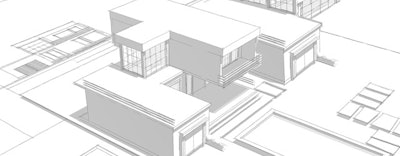
You're planning to renovate your athletic facility or maybe even build a new one. You have many items to consider and cover with your architect, design and management teams. Location, budget, schedule, programming, amenities, marketing, profit/loss — the list is long, and rightfully so. But have you missed anything?
 Johnny Boyd is the director of sports and recreation at Shive-Hattery Architecture and Engineering.
Johnny Boyd is the director of sports and recreation at Shive-Hattery Architecture and Engineering.
How about safety? It's a topic that is often missing from client/architect/management discussions. From day one through occupancy and operation, safety goals and expectations need to be included in all discussions of design, programming and management. Why? Because the safety of our clients and staff is the number one responsibility each of us has in the design and operation of all facilities.
To gain a better sense of safety's place in design, it may be helpful to review common owner/architect project communication in a simplified sense.
More than an assumption
When clients talk with their sports architect about facility program needs, they'll usually share details such as desired square footage, number of courts, required exercise equipment, quantity/type of studios, locker rooms, meeting areas, child care spaces and maximum budget.
The building programs are typically based on initial studies, including community surveys, competition analysis, demographic studies and multiple financial pro forma. Sports architects are then asked to take this information and begin to work with local building officials, site conditions, and building/trade markets to design a new facility that meets the owner's building program and budget, while delivering on the "wow" factor.
Somewhere in this process it is often assumed that "safety" is addressed. Safety deserves more than an assumption. Safety planning and execution affects owner/facility insurance rates, client recruitment and retention, staff utilization and efficiency, building size and location, parking, operational costs and, importantly, user safety.
For example, our firm was working with an independent owner designing and building a new recreation facility. We asked the owner if she and our team could talk with her insurance company to address any major and minor facility design insurance concerns. The insurance provider supplied her and our team with a checklist of common issues that affected her expected facility insurance costs. Our team was able to address many of these items — floor types in showers, exercise area lighting levels, facility signage, and staffing locations (internal visibility and observation) — during the design process, which in turn lowered her insurance premiums. Early safety discussions and planning make a big difference.
There are 10 key steps to making safety and security a key part of the relationship you develop with your sports architect.
Step 1: Safety and security is the top priority
• Take time to educate yourself.
• Contact your insurance company and ask for a discussion of common insurance safety-related concerns.
• Survey potential clients about their security and safety questions.
• Tour other facilities and note staffing numbers, staffing locations, interior and exterior lighting levels, floor types, signage, parking locations, parking-to-front-door visibility, door security, security cameras, and clear floor space between equipment units.
• Note quality of or lack of facility maintenance, both interior and exterior.
Step 2: Create a business safety statement
• Write out your safety goals for your facility, daily operations and business management.
• Spell out procedures and timelines for material selection, maintenance, client surveys and insurance audit.
• Include your safety statement in your written management, business and marketing plans.
• Include your safety statement in your building/project program.
Step 3: Develop an internal safety culture
• Promote safety and require all upper management and facility ownership to support safety and security in all aspects of the facility's design, operation, maintenance and management.
Step 4: Interview for safety and security
• Interview and ask prospective sports architects about their experience with safety and security design and integration.
• Select a sports architect with strong process of safety and security design and integration.
• Select a sports architect with an understanding of current best practices for safety and security design, materials and supporting technologies.
Step 5: Outline project safety and security goals
• Meet with your sports architect and outline project goals and requirements.
• Provide a written building/facility program that clearly states that safety and security are top priorities.
• List expectations, including required diligence for insurance response, floor material selection, building material selection, material durability, lighting level review, entry/exit visibility, building code compliance, door security, security camera placement/coverage, parking lighting/security, equipment placement, and interior staffing locations for internal visibility.
Step 6: Contract for safety and security
• Include a safety and security provision in the contract/agreement with your architect.
• List safety and security goals, required documentation and other pertinent information in the contract/agreement.
Step 7: REQUIRE REGULAR REVIEWS
• Require reviews of safety and security design in every meeting with your architect and design team.
• Ask questions about how a decision affects safety and security.
• Ask questions about how material selections affect safety and security.
• Ask questions about how specific insurance concerns are being addressed.
• Review client surveys and expressed safety concerns with your architect, and develop design responses.
Step 8: Promote and market safety and security
• Work with your architect and design team to develop drawings and project data at specific periods during design to highlight safety and security features.
• Use drawings and data in promotional materials (posters, advertisements, social media) that highlight your safety and security efforts.
Step 9: HOLD EVERYONE ACCOUNTABLE
• Hold all team members accountable for safety- and security-related selections and decisions.
• Require changes to design and systems that do not meet your stated safety and security goals.
Step 10: Review and Update
• Review your written safety statement and business plan monthly and update as needed.
• Conduct periodic client and staff surveys of safety and security concerns at your completed facility.
• Share results with your architect.
• Engage your architect to make changes and updates, regularly addressing client and staff concerns.
• Maintain and repair damaged or failing items at your facility immediately, as deferred maintenance is often listed in gathered surveys as a leading safety concern.
Safety and security must be top-of-mind concerns. Facility owners, operators and architects share the responsibility for designing facilities that offer visitors not only a rewarding experience but a safe environment.
This article originally appeared in the May 2019 issue of Athletic Business with the title "Safety takes the lead in facility planning." Athletic Business is a free magazine for professionals in the athletic, fitness and recreation industry. Click here to subscribe.
































